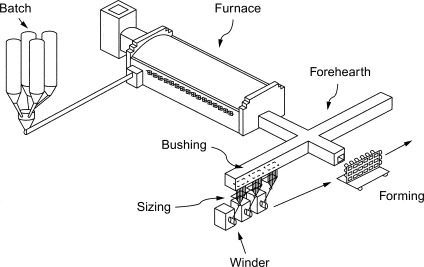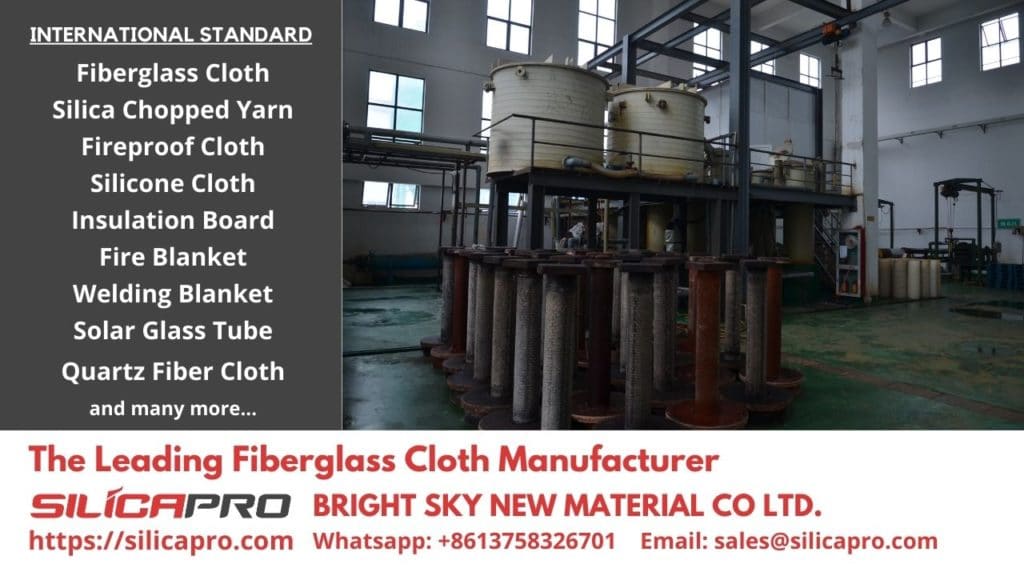
Glass Fiber Manufacturing Process, source: https://www.sciencedirect.com/science/article/abs/pii/B9780081018712000059
Fiberglass is a composite material made from glass fibers placed within a polymer matrix, typically using epoxy or polyester resin. The manufacturing process for fiberglass involves several critical steps, with batching as a fundamental stage. Let’s dive into the details to understand what the fiberglass batching process entails.
The fiberglass batching process involves carefully combining the main ingredients to produce fiberglass. This batching includes mixing glass fibers with a polymer matrix, as well as incorporating additives that enhance specific properties of the final product.
Fiberglass batching is essentially the initial step in creating fiberglass, where raw materials are prepared for processing in a furnace or molding equipment. In this phase, precise measurement and mixing are essential to ensure that each ingredient contributes to the final product’s desired mechanical and physical characteristics.
Achieving a uniform distribution of glass fibers and resin is the main objective of the batching process, allowing the fiberglass to form a hard, strong structure upon curing. This stage is critical in producing a lightweight, corrosion-resistant material with superior strength and durability.
Quality control is essential in the batching process to verify that proportions are accurate and that the final product meets industry standards. Various industries use fiberglass to create products like panels, tanks, automotive components, and construction materials. For each application, technicians make specific adjustments during batching to ensure the product meets its unique standards.
For a deeper understanding, let’s explore each step in the fiberglass batching process.
Contents
Steps in the Fiberglass Batching Process
Creating fiberglass involves several steps, starting from raw material preparation to the final curing and finishing stages. Each phase contributes to the quality and consistency of the final fiberglass product.
Preparation of Glass Fiber
Manufacturers generally produce glass fiber in sheets or rolls. Before it’s used, technicians cut or shape the fibers to the required length and form, tailored to the specific needs of the final product. This preparation step is essential to ensure uniformity and proper alignment within the composite.
Matrix Mixing
Polymer resins, such as epoxy or polyester, are measured and mixed with fillers, hardeners, or additives, as necessary. The precise proportions of these ingredients are crucial for creating a homogeneous mixture and achieving the desired strength and durability in the final product.
Resin Application to Glass Fiber
Once prepared, the resin mixture is applied to the glass fibers using techniques like spraying, brushing, or casting. The goal is to ensure that the fibers are evenly saturated with resin to create a cohesive, stable composite material. This stage ensures that the glass fibers bond properly, providing both structural integrity and flexibility.
Drying and Hardening
Once the resin is applied, the material begins a drying and curing process that hardens the resin, forming a rigid structure. During this phase, technicians carefully control the drying time and curing temperature, which vary based on the resin type, to ensure the fiberglass achieves optimal properties.
Finishing
Once cured, fiberglass products can go through finishing processes such as sanding, trimming, or cutting to meet the desired final specifications. Finishing ensures that the product’s appearance and dimensions are tailored to its intended application.
Automation and Technology in the Batching Process
Technological advancements have significantly improved the fiberglass batching process. Today, computerized weighing systems ensure precise measurements of raw materials, enhancing consistency across batches. Additionally, closed material transport systems help maintain cleanliness and safety during batching, minimizing contamination risks and ensuring product purity.
Why the Fiberglass Batching Process is Important
The fiberglass batching process is a critical foundation for creating high-quality fiberglass products. Ensuring correct ingredient proportions and thorough mixing is essential to achieve fiberglass’s required performance standards. These standards include durability, strength, and resistance to environmental factors. Proper batching also preserves the lightweight and corrosion-resistant qualities of fiberglass, making it valuable in many applications.
Understanding fiberglass batching intricacies benefits both industry professionals and users. This knowledge helps manufacturers maintain consistent quality and allows users to appreciate the complexity behind this versatile material.

